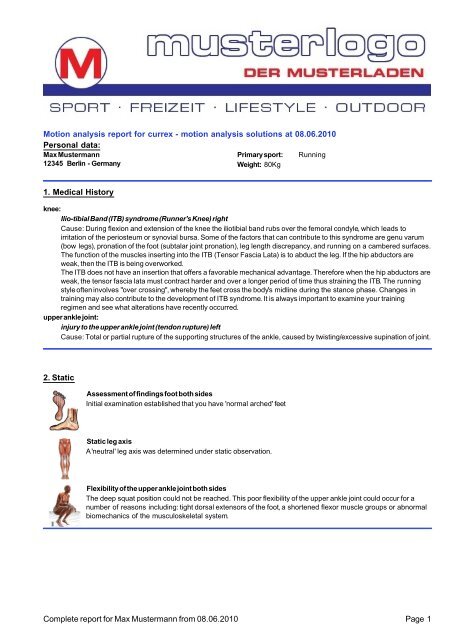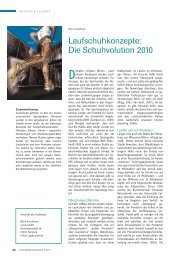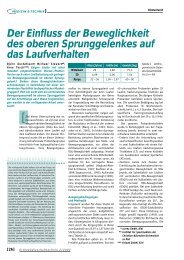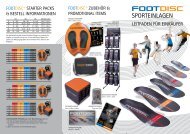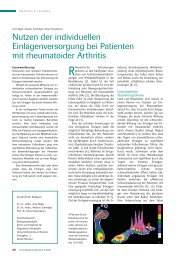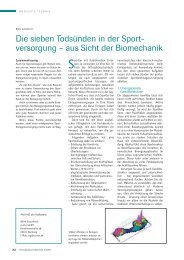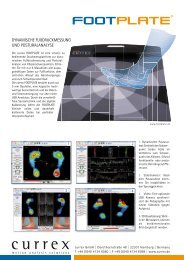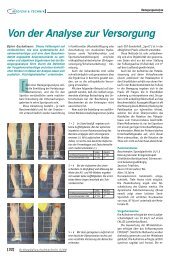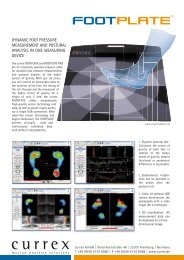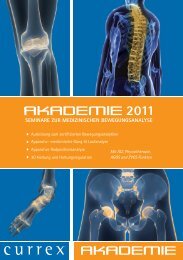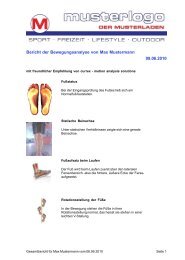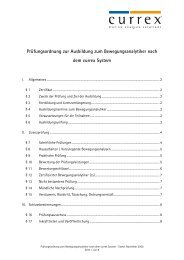MOTIONQUEST Professional sample report as PDF - currex
MOTIONQUEST Professional sample report as PDF - currex
MOTIONQUEST Professional sample report as PDF - currex
Create successful ePaper yourself
Turn your PDF publications into a flip-book with our unique Google optimized e-Paper software.
Motion analysis <strong>report</strong> for <strong>currex</strong> - motion analysis solutions at 08.06.2010<br />
Personal data:<br />
Max Mustermann<br />
12345 Berlin - Germany<br />
1. Medical History<br />
Primary sport: Running<br />
Weight: 80Kg<br />
knee:<br />
Ilio-tibial Band (ITB) syndrome (Runner's Knee) right<br />
Cause: During flexion and extension of the knee the iliotibial band rubs over the femoral condyle, which leads to<br />
irritation of the periosteum or synovial bursa. Some of the factors that can contribute to this syndrome are genu varum<br />
(bow legs), pronation of the foot (subtalar joint pronation), leg length discrepancy, and running on a cambered surfaces.<br />
The function of the muscles inserting into the ITB (Tensor F<strong>as</strong>cia Lata) is to abduct the leg. If the hip abductors are<br />
weak, then the ITB is being overworked.<br />
The ITB does not have an insertion that offers a favorable mechanical advantage. Therefore when the hip abductors are<br />
weak, the tensor f<strong>as</strong>cia lata must contract harder and over a longer period of time thus straining the ITB. The running<br />
style often involves "over crossing", whereby the feet cross the body's midline during the stance ph<strong>as</strong>e. Changes in<br />
training may also contribute to the development of ITB syndrome. It is always important to examine your training<br />
regimen and see what alterations have recently occurred.<br />
upper ankle joint:<br />
injury to the upper ankle joint (tendon rupture) left<br />
Cause: Total or partial rupture of the supporting structures of the ankle, caused by twisting/excessive supination of joint.<br />
2. Static<br />
Assessment of findings foot both sides<br />
Initial examination established that you have 'normal arched' feet<br />
Static leg axis<br />
A 'neutral' leg axis w<strong>as</strong> determined under static observation.<br />
Flexibility of the upper ankle joint both sides<br />
The deep squat position could not be reached. This poor flexibility of the upper ankle joint could occur for a<br />
number of re<strong>as</strong>ons including: tight dorsal extensors of the foot, a shortened flexor muscle groups or abnormal<br />
biomechanics of the musculoskeletal system.<br />
Complete <strong>report</strong> for Max Mustermann from 08.06.2010 Page 1
3. Dynamics<br />
4. Stride pattern<br />
Dynamic leg axis left<br />
Your leg axis is 'normal' in both the static and<br />
dynamic observations. The knee bend occurs<br />
inline with the 'leg axis' (on a straight line<br />
extending from your foot to your hip). This<br />
indicates that your knee kinematics lie within<br />
healthy boundaries.<br />
Pelvis stability<br />
Adequate pelvic stability is evident on both the left and right sides.<br />
Overcrossing<br />
Both feet are placed along side the body mid-line.<br />
right<br />
Your leg axis, which is 'normal' when statically<br />
analysed, internally rotates during the dynamic<br />
mid-stance ph<strong>as</strong>e. This causes rotational<br />
forces between the tibial plateau and the<br />
femoral condyle of the knee.<br />
Rotation of the foots about its longitudinal axis both sides<br />
Normal foot rotation is evident, this means that you stand with your feet in a slight 'V' position.<br />
Initial contact both sides<br />
If the heel makes first contact with the ground during a normal running stride, the individual is categorised <strong>as</strong> a<br />
'heel striker'.<br />
Stance ph<strong>as</strong>e<br />
During the stance ph<strong>as</strong>e pronation is evident. Pronation is the normal and necessary inward role of the foot to<br />
help attenuate the impact of foot strike.<br />
Toe-off both sides<br />
Toe-off occurs over the II-III metatarsal heads. The calcaneus stays neutral during the propulsive ph<strong>as</strong>e of<br />
stance.<br />
Complete <strong>report</strong> for Max Mustermann from 08.06.2010 Page 2
5. Recommendation<br />
Shoe recommendation<br />
Your foot remains neutral throughout the stance ph<strong>as</strong>e. Therefore you require a neutral running shoe. Avoid<br />
footwear with additional supportive structures on the medial <strong>as</strong>pect.<br />
Orthopedic me<strong>as</strong>ures<br />
Your foot remains neutral throughout the stance ph<strong>as</strong>e therefore requires no additional support.<br />
Complete <strong>report</strong> for Max Mustermann from 08.06.2010 Page 3
Foot-analysis data<br />
Length:<br />
Width:<br />
Foot type:<br />
left<br />
28,55 cm<br />
10,85 cm<br />
(middle)<br />
normal foot<br />
right<br />
28,71 cm<br />
10,78 cm<br />
(middle)<br />
normal foot<br />
The result are the following shoe sizes:<br />
B<strong>as</strong>ed on me<strong>as</strong>urements of your foot length and<br />
requirements of the running shoe, we recommend the<br />
following shoe size- and width:<br />
EU:<br />
UK:<br />
US:<br />
JPN:<br />
45<br />
10,5<br />
11,5<br />
29,5<br />
Note: Your shoe size may vary by up to one EUR size,<br />
depending on the shoe manufacturer or model.<br />
Foot analysis results:<br />
Normal/neutral feet have a well developed longitudinal arch, consequently the medial and lateral<br />
<strong>as</strong>pect of the foot are stressed equally during weight bearing activities.<br />
Complete <strong>report</strong> for Max Mustermann from 08.06.2010 Page 4
Personal exercise plan for Max Mustermann Kindly recommended by <strong>currex</strong> -<br />
motion analysis solutions at 08.06.2010<br />
The b<strong>as</strong>ics about strengthening<br />
Strong, fatigue resistant, trained muscles will help protect against injury and optimise<br />
running efficiency, speed and technique. The following exercises are recommended<br />
specifically for you <strong>as</strong> they address are<strong>as</strong> of weakness. Ensure you follow these<br />
guidelines:<br />
1. Complete 3-4 sets of each dynamic exercise, with 15-25 repetitions in each set.<br />
Complete each static exercise 3-4 times, holding each position for 10-30<br />
seconds. Ideally you should do strength training 3-4 times a week.<br />
2. Take care to perform each exercise correctly.<br />
3. Breathe deeply and regularly <strong>as</strong> you perform each exercise.<br />
4. Hold you head up.<br />
5. Always perform the exercises slowly and in a controlled manner.<br />
6. This is a program for healthy individuals. Ple<strong>as</strong>e consult a medical professional if<br />
you have any doubts about your cardiov<strong>as</strong>cular or physical health before starting<br />
training.<br />
Thigh Abductors<br />
Start position: Lie down on your side with the leg nearest<br />
the floor slightly bent.<br />
Execution: Lie on your side. Now raise the upper leg <strong>as</strong> far<br />
<strong>as</strong> is comfortably possible. Then gently lower the upper leg<br />
until it is resting on the lower leg again. Repeat the<br />
movement sequence.<br />
left and right Gluteus<br />
Start position: Lie on your back, with your knees bend to<br />
90 degrees (<strong>as</strong> if you were going to do a sit-up).<br />
Execution: Lift your pelvis up so that your shoulders pelvis<br />
and knees create a straight line. Hold this position.<br />
Complete <strong>report</strong> for Max Mustermann from 08.06.2010 Page 5
Piriformis (pear shaped muscle in the gluteus<br />
region)<br />
Start position: Stand barefoot, externally rotate you leg so<br />
that your feet point out. You should feel the stretch on the<br />
medial <strong>as</strong>pect of your thigh.<br />
Execution: Stand on your tiptoes, keeping your weight<br />
predominantly on the big toes. Now take small sideways<br />
steps, keeping on your tiptoes throughout.<br />
Avoid: Keep your heels together.<br />
leg raises (leg abduction)<br />
Start position: lying on your side prop yourself up on your<br />
forearm.<br />
Execution: Now lift the hips so that your shoulders,<br />
stomach, hips and legs form a straight line. Hold this<br />
position <strong>as</strong> long <strong>as</strong> you can.<br />
Tibialis anterior (muscle located at the front of<br />
the tibia)<br />
Start position: Stand with your weight on your heels.<br />
Execution: Slowly lift your forefoot, keeping your heels on<br />
the ground. Hold this position for about five seconds then<br />
lower your forefoot. Then repeat the exercise.<br />
Complete <strong>report</strong> for Max Mustermann from 08.06.2010 Page 6
V<strong>as</strong>tus medialis (inner thigh muscle)<br />
Start position: Stand facing forward, legs shoulder width<br />
apart. Step forward and bend your left knee to about 40°,<br />
stretching your back leg behind you keeping your knee<br />
inline with the hip and foot.<br />
Execution: Now flex and extend the knee of the front leg in<br />
a controlled manner. Do not let the knee collapse laterally<br />
- keep the knee flexing on an imaginary straight line from<br />
your hip to your foot.<br />
Avoid: Take care if your have, or are vulnerable to knee<br />
injuries/pain.<br />
The b<strong>as</strong>ics about stretching<br />
specific muscle tightness is one of the leading causes of injury amongst runners.<br />
Stretching effectively relieves muscle tightness, helping attain muscle balance and<br />
synergy. Consequently it is imperative to stretch regularly and properly:<br />
1. Only stretch when you are warm, e.g. after your run or other form of cardiov<strong>as</strong>cular exercise.<br />
2. Get in to the correct position and push until you feel tension in the muscle your are<br />
stretching. However, don't try to incre<strong>as</strong>e flexibility too quickly by forcing yourself.<br />
Stretch no further than the muscles will go without pain.<br />
3. Hold the stretch for up to 40 seconds. Repeat each stretch 3 times, alternating<br />
sides.<br />
4. Breathe deeply and regularly while you are stretching. Try to keep your core stable at all times<br />
Warning: Avoid stretching painful muscles/tendons!<br />
Adductors (thigh flexor)<br />
Start position: Stand with you legs in a straddle position,<br />
with your feet facing forward. Bend one knee.<br />
Execution: Now bring your arm up over the head and lean<br />
your upper body towards the bent knee. You should feel<br />
the stretching on the inner side of your thigh.<br />
Complete <strong>report</strong> for Max Mustermann from 08.06.2010 Page 7
G<strong>as</strong>trocnemius (calf muscles)<br />
Start position: Stand tall with one leg in front of the other,<br />
with hands pressing against a wall at shoulder height.<br />
E<strong>as</strong>e your back leg further away from the front leg, keeping<br />
it straight (but not locked) and press the heel firmly into the<br />
floor. Keep your hips facing forward and the rear leg and<br />
spine in a straight line. You will feel the stretch in the calf<br />
of the rear leg.<br />
Execution: Push your hips forward until you feel a stretch<br />
in the calf.<br />
Gluteus (buttocks)<br />
Start position: Lay flat on your back, legs straight. Now<br />
pull your right leg up and lay the out-side of the left ankle<br />
on the right knee.<br />
Execution: Now, use both hands to pull your right knee up<br />
to your chest. You should feel the stretch in your buttocks.<br />
Iliopso<strong>as</strong> (hip extensor muscle)<br />
Start position: Kneel on the left leg, the right extended in<br />
front.<br />
Execution: Lunge forward, keeping your weight over your<br />
front leg. Push your hips forward until you feel the stretch<br />
in your groin. Hold this position for 15 seconds. Repeat<br />
with the other leg forward. Ensure you keep your torso<br />
straight throughout the exercise.<br />
Avoid: Do not hunch your back!<br />
Complete <strong>report</strong> for Max Mustermann from 08.06.2010 Page 8
Hamstrings (large muscle group on the dorsal<br />
<strong>as</strong>pect of the thigh)<br />
Start position: Stand with one foot just in front of the other.<br />
Bend the back knee keeping the front knee straight.<br />
Execution: Now bend forward at the hips. You should feel<br />
the stretch along the posterior <strong>as</strong>pect of the upper leg.<br />
Avoid: Do not place your feet to far apart. Keep Your back<br />
straight.<br />
Quadriceps (large muscle group on the front of<br />
the thigh)<br />
Start position: Stand tall (balance by holding a stationary<br />
object if required), fully flex your right knee, grabbing your<br />
ankle with the right hand, pull your rearfoot to your<br />
buttocks. Hold for 20-30 seconds then repeat with the<br />
other leg. Incre<strong>as</strong>e the stretch by pushing the hips forward<br />
whilst holding the stretch.<br />
Execution: Stand on one leg. Bend your knee and pull your<br />
foot up behind you. Keeping the knee close to the body,<br />
gently pull your heel into your bottom until you feel tension<br />
in the front of your thigh.<br />
Avoid: Do not let your upper body tilt forward!<br />
Soleus (calf muscle, originates at the proximal<br />
end of the Achilles tendon)<br />
Start position: Stand tall with one leg in front of the other,<br />
with hands pressing against a wall at shoulder height.<br />
E<strong>as</strong>e your back leg further away from the front leg, keeping<br />
it straight (but not locked) and press the heel firmly into the<br />
floor. Keep your hips facing forward and the rear leg and<br />
spine in a straight line. You will feel the stretch in the calf<br />
of the rear leg.<br />
Execution: Stand tall, one leg slightly in front of the other.<br />
Bend you back leg, keeping your heel on the floor until you<br />
feel the stretch in the Achilles tendon and soleus. Hold for<br />
15-30 seconds then repeat with the other leg forward.<br />
Avoid: Do not twist your hips, keep them at a 90° angle to<br />
the wall.<br />
Complete <strong>report</strong> for Max Mustermann from 08.06.2010 Page 9
Tensor f<strong>as</strong>ciae latae (plays a role in hip flexion,<br />
Abduction and medial rotation)<br />
Start position: Stand next to a wall with the foot furthest<br />
from the wall about 30cm in front of the other. Prop your<br />
self against a wall with your forearm so that you lean into<br />
the wall. Now bring the front leg towards the wall so that<br />
your legs are crossed.<br />
Execution: Now, push your hips sideways towards the<br />
wall. If you do not feel this is stretching your thigh<br />
sufficiently then move your left leg further from the wall.<br />
Complete <strong>report</strong> for Max Mustermann from 08.06.2010 Page<br />
10
Shoe recommendation after computer analysis from 08.06.2010<br />
for Max Mustermann created by:<br />
<strong>currex</strong> - motion analysis solutions<br />
These running shoes offer the correct balance between cushioning and support for a<br />
neutral runner, such <strong>as</strong> yourself.<br />
Optimal stability and cushioning for you.<br />
Optimal stability and good cushioning for<br />
you.<br />
This shoe will provide good stability and<br />
cushioning for you.<br />
This shoe offers your foot good stability,<br />
the cushioning properties acceptable.<br />
The stability of this shoe is insufficient, the<br />
cushioning properties are perfect for you.<br />
This shoe is both insufficiently cushioned<br />
and stabilised for you.<br />
Model Suitability Width Application Price<br />
New Balance MR 1906 Training 200 EUR<br />
Asics GEL KINSEI 3 Training 199,95 EUR<br />
ECCO Biom C Mesh Training and<br />
competition<br />
Newton Gravity Training and<br />
competition<br />
Newton Distance Training and<br />
competition<br />
180 EUR<br />
179 EUR<br />
174 EUR<br />
Mizuno Wave Creation 11 Training 160 EUR<br />
Asics GEL-NIMBUS 11 Training 159,95 EUR<br />
Zoot Ultra Race 2.0 Competition 150 EUR<br />
Complete <strong>report</strong> for Max Mustermann from 08.06.2010 Page<br />
11


